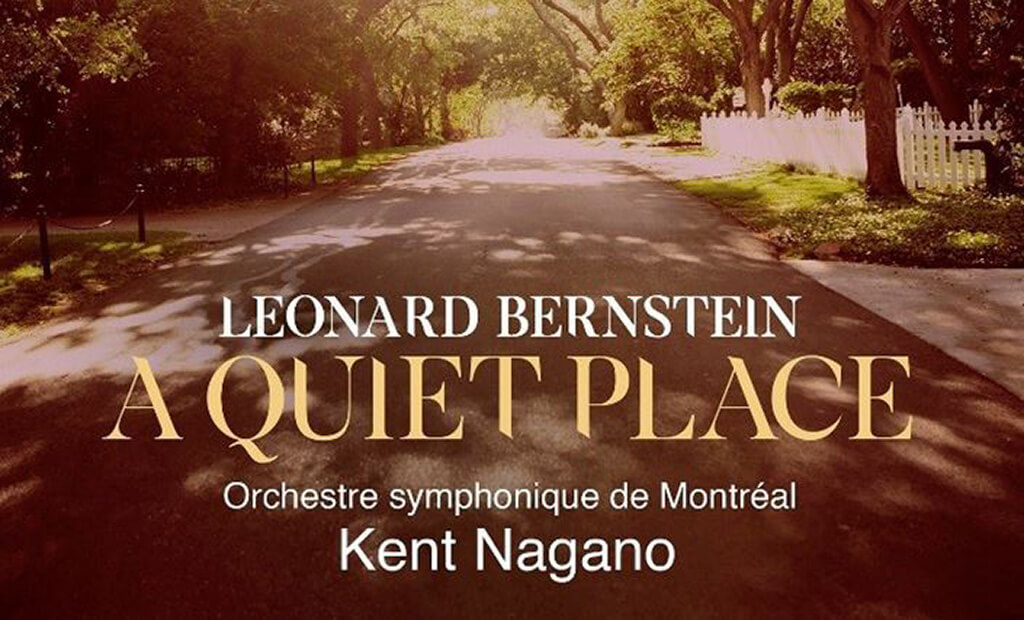
Bernstein: A Quiet Place. Music by Leonard Bernstein. Libretto by Stephen Wadsworth. Libretto and Orchestration adapted by Garth Edwin Sutherland. WORLD PREMIERE RECORDING OF THE 2013 VERSION. Claudia Boyle (Dede). Joseph Kaiser (Francois). Gordon Bintner (Junior). Lucas Meachem (Sam). OSM Chorus. Orchestre symphonique de Montréal/Kent Nagano. Decca 483 3895. Total Time: 93:04.
The 1983 Houston premiere of the opera A Quiet Place, the major work of Leonard Bernstein’s later years, was a fiasco. Since then, several attempts have been made to rework the composition, the most recent of which is captured in this new recording. A significant improvement over the original, it nevertheless remains to be seen whether A Quiet Place will ever become one of the jewels in the Bernstein Pantheon.
A somewhat jazzy satire on life in suburbia in the 1950s, Bernstein’s one-act opera Trouble in Tahiti, composed in 1952, focused on the lives of a married couple, Sam and Dinah. Thirty years later, in A Quiet Place, Bernstein and his librettist Stephen Wadsworth revisited the couple. In A Quiet Place, many years have passed. Dinah has just been killed in a car crash. We later learn that it may have been suicide. Sam and the children gather for her funeral and the interactions between them make it clear that this was an unhappy, dysfunctional family. After seemingly endless bickering and recriminations, at the end of the opera, there is a tentative reconciliation.
The 1983 Houston premiere of A Quiet Place opened with Trouble in Tahiti. After intermission, the 110 minutes of A Quiet Place was performed without a break. While the life story of Sam and Dinah provided some continuity to link the two operas, musically they were as different as chalk and cheese. In the 1983 production Bernstein’s quasi-Broadway 1950s Trouble in Tahiti style had morphed into something far more dissonant; the often amusing bickering had become angrier and much more personal. A Quiet Place also gave us mental illness, homosexuality and incest, all of which made Houston audiences uncomfortable.
Bernstein and Wadsworth reworked A Quiet Place again after the Houston premiere. This time, they cut a great deal of the opera and incorporated Trouble in Tahiti as a flashback. Although this version was produced at the Vienna State Opera and recorded (DG 419761) in 1986, Bernstein was still dissatisfied with the opera and probably would have attempted another version had he not passed away in 1990.
Conductor Kent Nagano, who had worked closely with Bernstein during the Vienna performances, felt that a revised version should eliminate Trouble in Tahiti altogether, restore some of the music eliminated in the 1986 version, and, above all, use a reduced orchestration. The orchestra required for both the original Houston version in 1983 and for the 1986 Vienna version was huge and often overwhelmed the voices and obscured the text. The man tasked by Kent Nagano with scaling down the orchestration for this 2013 version was Garth Edwin Sutherland. He reduced the original complement of more than 72 players to a mere 18 and eliminated much of the percussion as well as the electric guitar and the synthesizer, with the result that the instrumental textures are much lighter and more appropriate to what is, for the most part, a chamber opera for four singers. While one assumes that with a smaller orchestra it is easier to hear the voices and understand the words, that is impossible to judge based on a recording; balance issues can be easily rectified by a skilled engineer.
It should be emphasized that Sutherland not only reduced the orchestration but also made major changes in the content and structure of the opera; for example, he restored three arias that were cut from the Vienna version and “reassigned the reading of Dinah’s letter, ‘Dear Loved Ones,’ from Junior to François.” It is certainly questionable whether it is ethical to make such wholesale revisions to the score without authorization from the composer. Perhaps this should be called the Bernstein-Sutherland version.
Ethical questions aside, the performance could hardly be better. The playing of the OSM musicians is consistently brilliant and Nagano shapes the music with authority. The soloists are all excellent, especially baritone Lucas Meachem (Sam) who delivers his long solos with a wide range of expression.
In this Bernstein 100th-anniversary year, a new recording of A Quiet Place is certainly welcome, although it is still not clear that this opera will win new friends. The story of this dysfunctional American family certainly reflects some of the widespread societal tensions of its time and there are moments of great tenderness in both the text and the music, but the opera overall remains almost unbearably bleak and depressing, and as in Bernstein’s Mass the reconciliation at the end can seem abrupt and unconvincing.
There are certainly equally dark works in the operatic repertoire — Richard Strauss’ Elektra and Berg’s Wozzeck come to mind — but musically A Quiet Place is simply not in the same league.
- SCRUTINY | TSO Lets Berlioz Do The Talking In Season Opener - September 21, 2018
- RECORD KEEPING | Even Yannick Nézet-Séguin Can’t Make Us Love Mozart’s La Clemenza di Tito - September 6, 2018
- RECORD KEEPING | Giovanna d’Arco With Anna Netrebko Explains Why The Best Operas Survive - August 30, 2018



